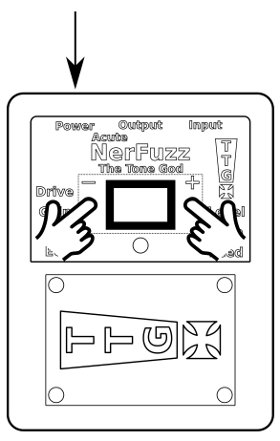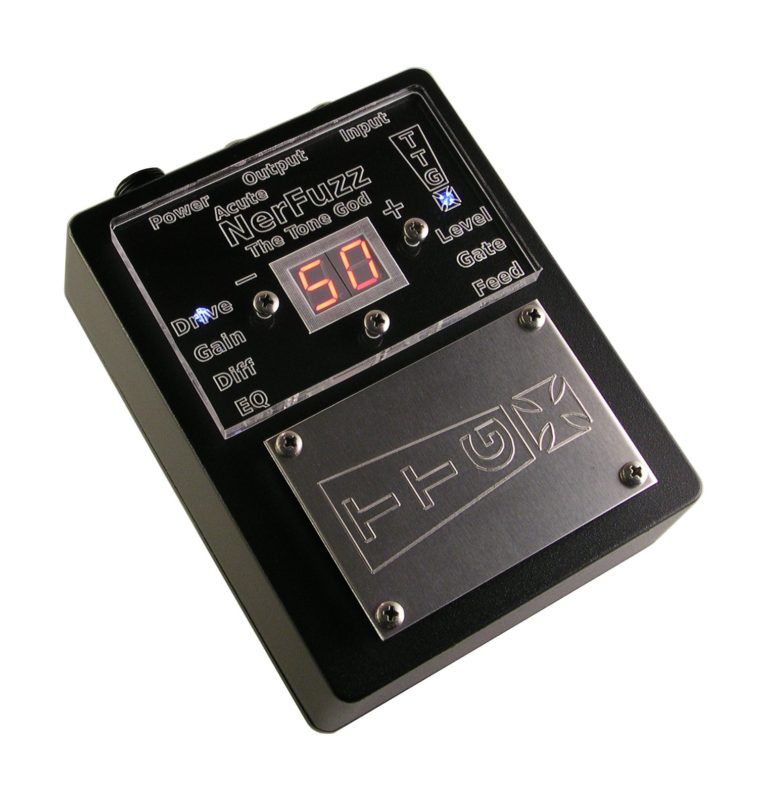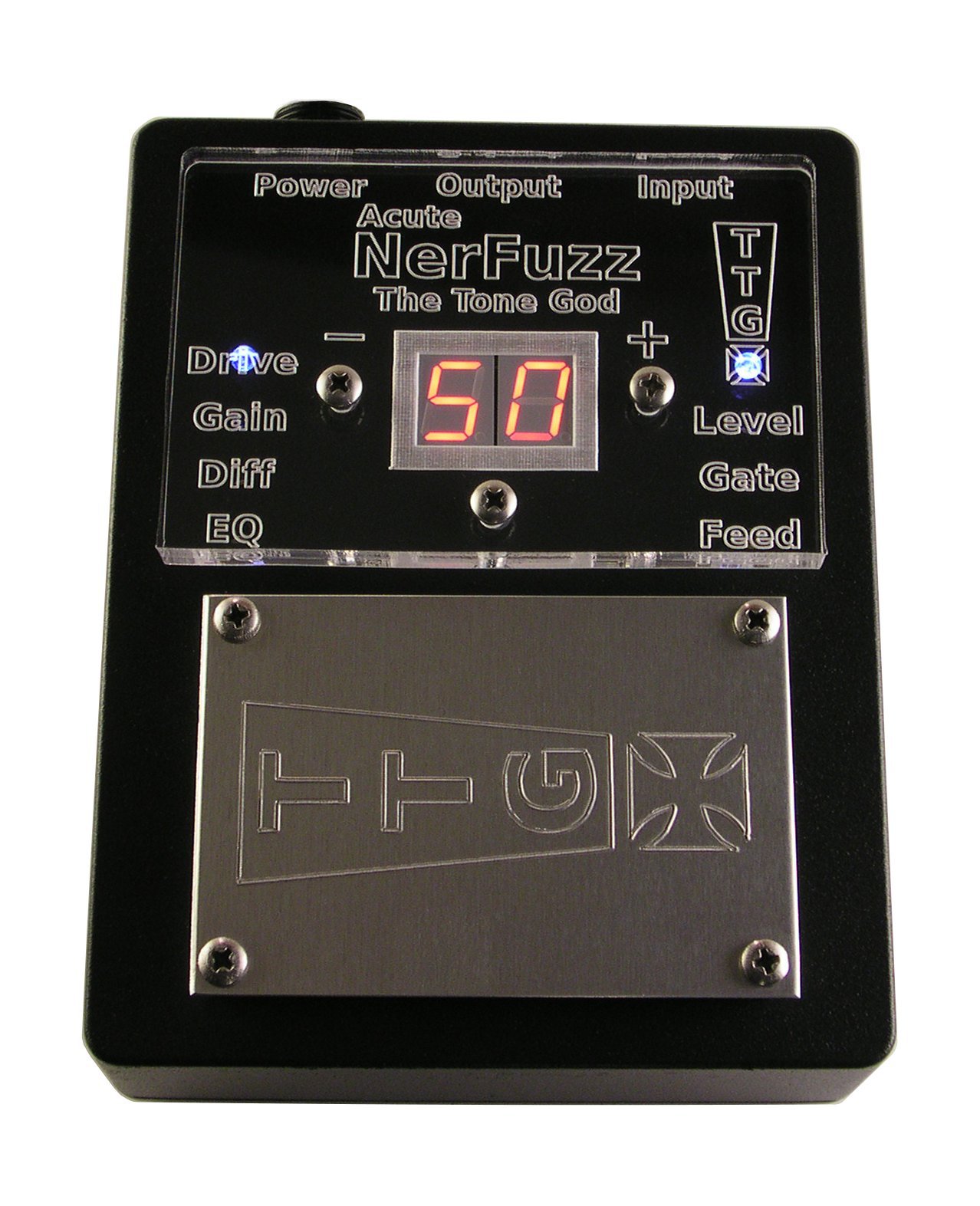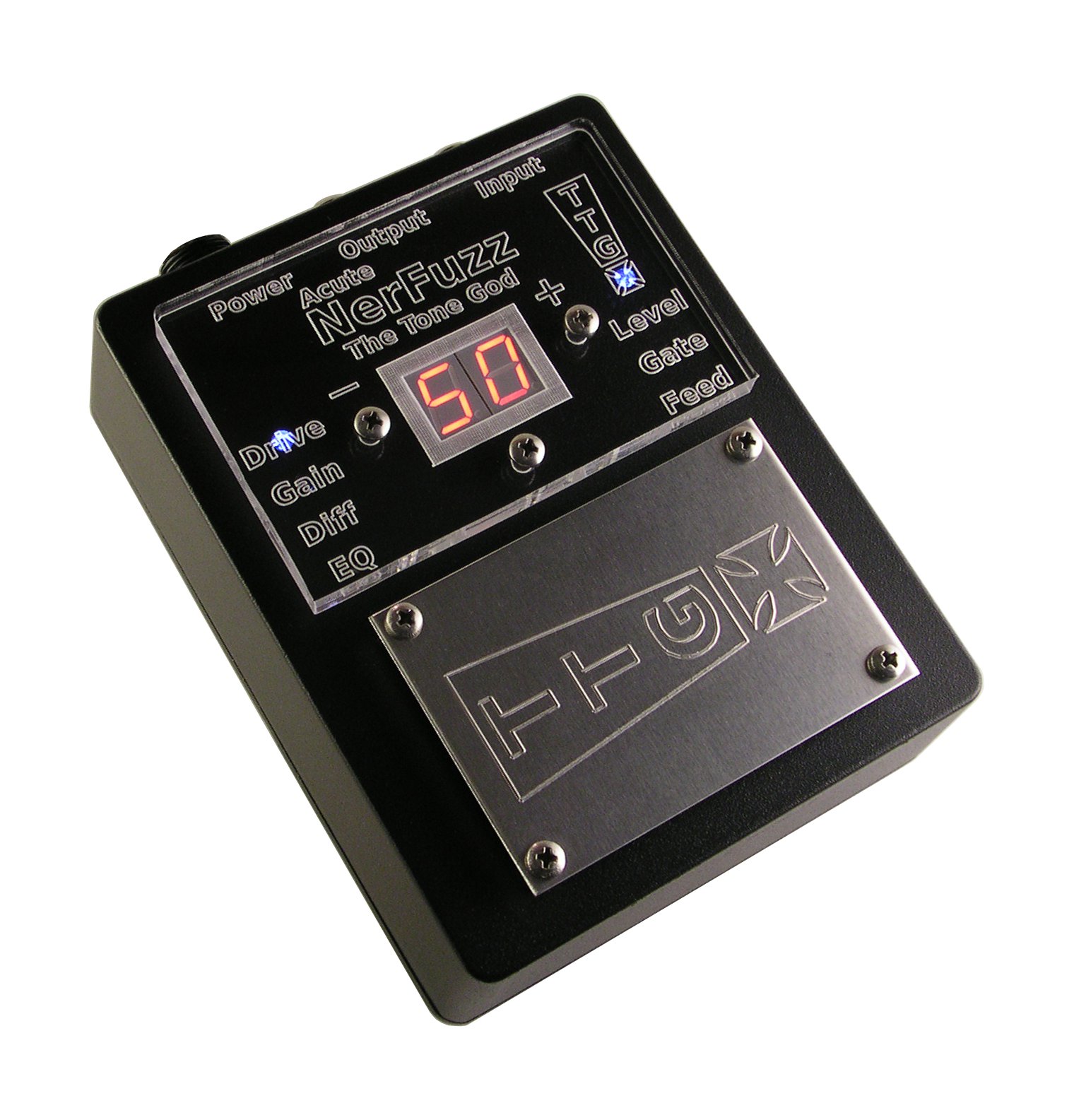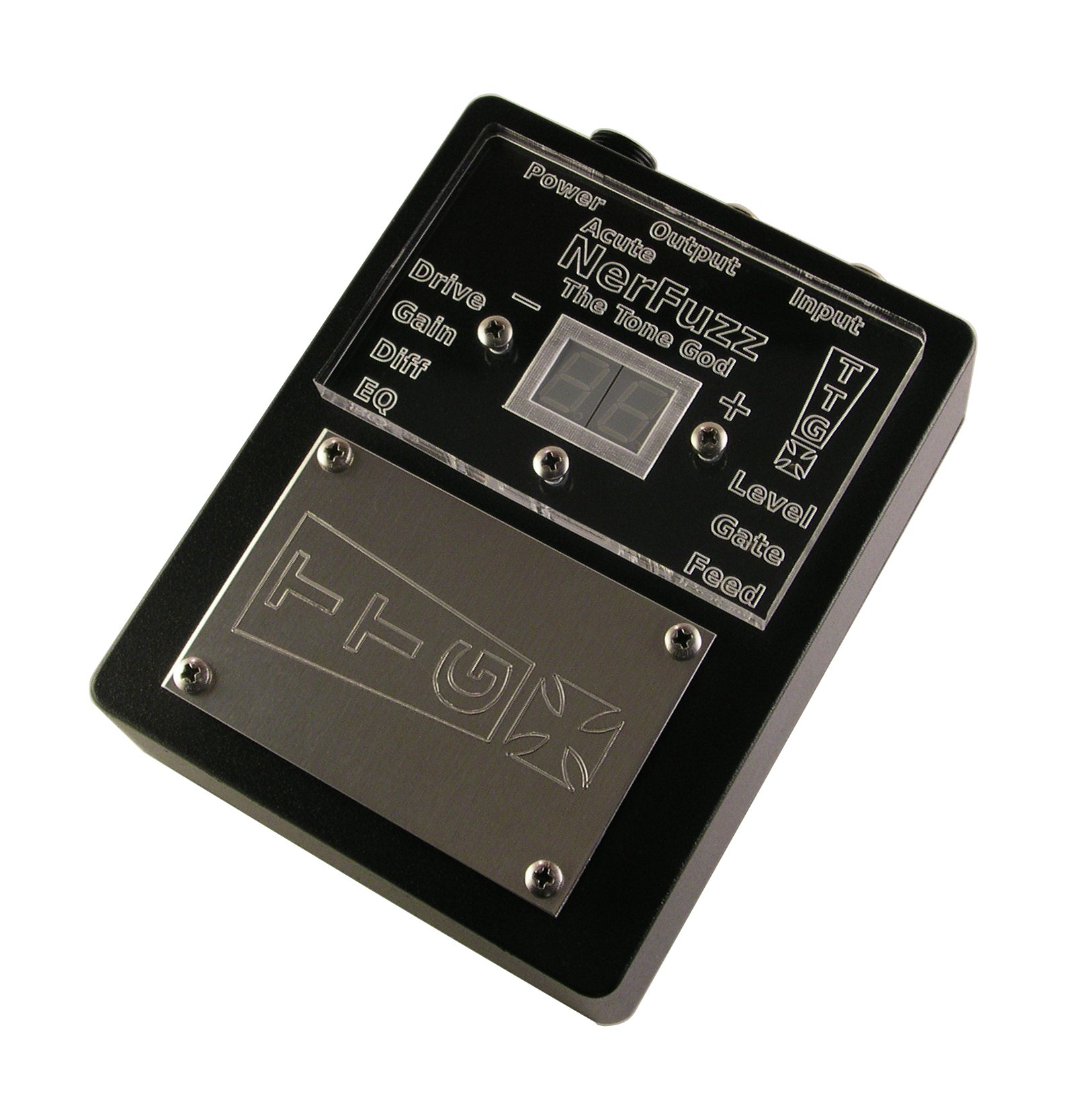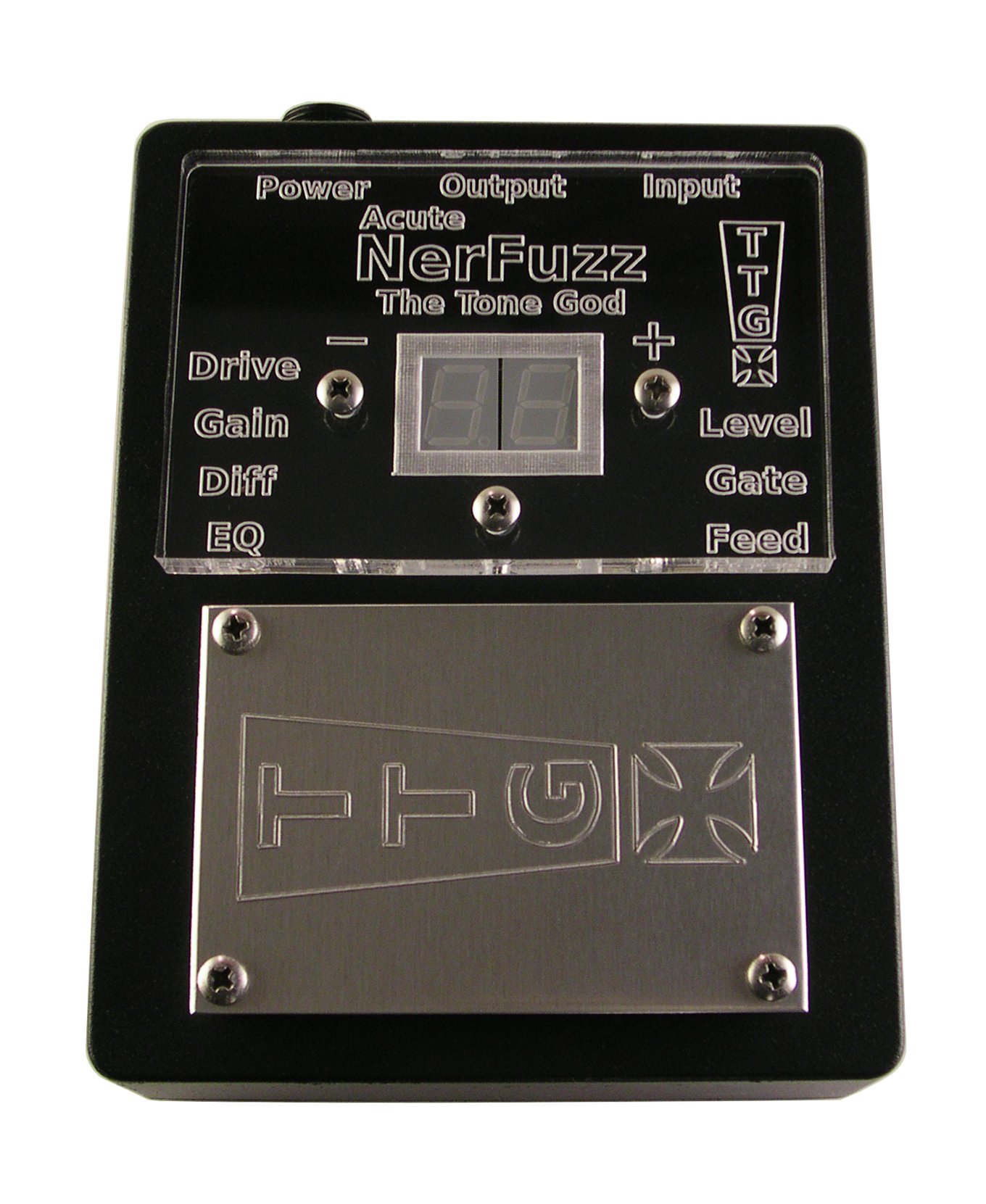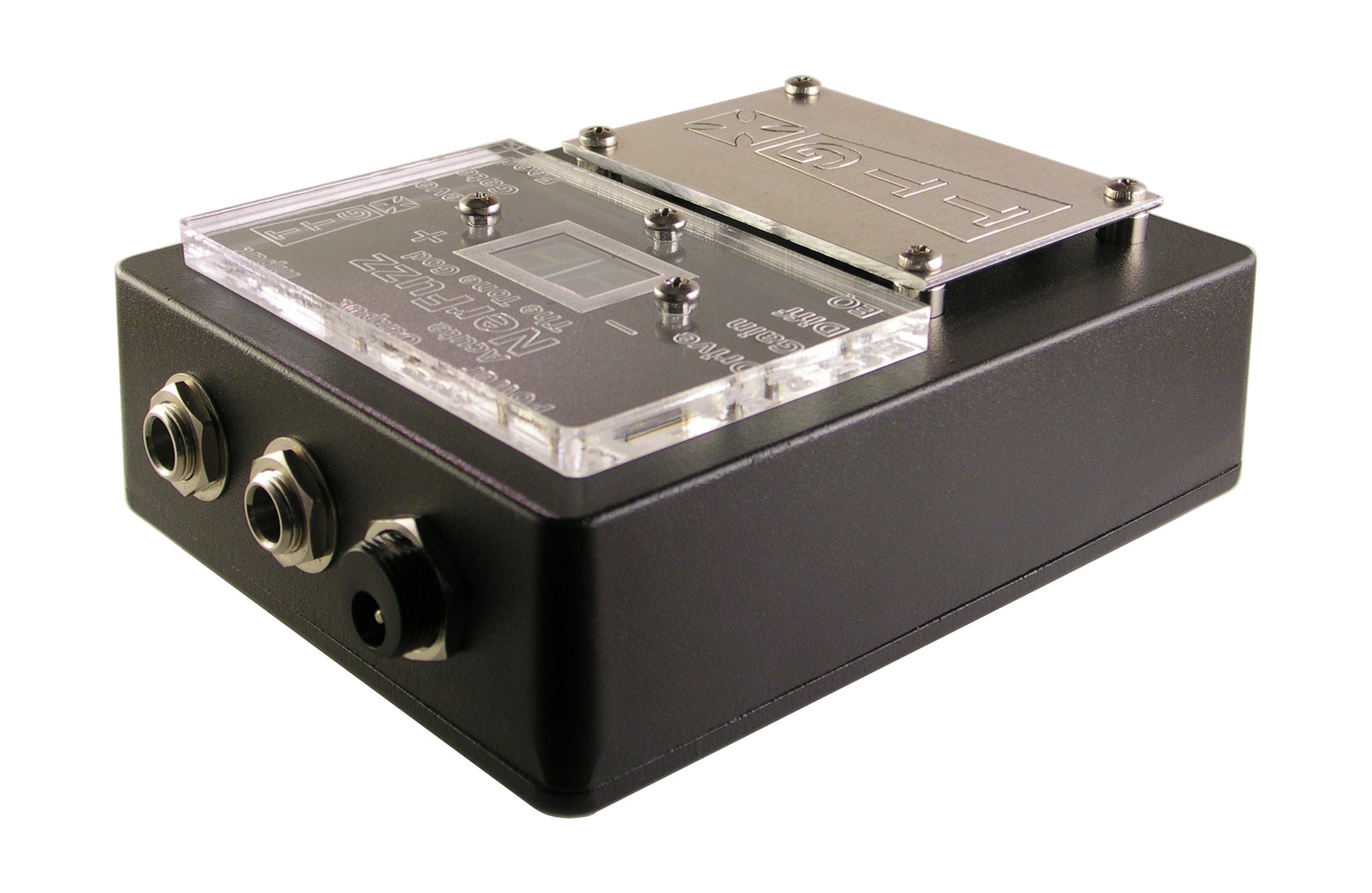The Acute NerFuzz is the mini version of the NerFuzz. Created for those who want a simple but versatile version of the NerFuzz that will not take up as much of their precious pedal board real estate. Despite it’s smaller size it can still produce most of the wide range of sounds available in the NerFuzz. Still included are the fuzz sounds going from mild overdrive to fuzz chaos, vintage to modern tones, blues to experimental styles using seven control parameters. All of the controls from NerFuzz are included in the Acute NerFuzz except the three band EQ has been replaced with a single low / mid band EQ control. Of course all these tones are created using a 100% analog signal path.
Continuing the tradition the Actue NerFuzz uses a touch interface which only responds to skin contact. There is no worry that settings will be changed by mishandling either in transit or in performance. There are no knobs to break off or difficulties seeing settings on stage. The large bypass control plate should be able to take just about any abuse one can throw at it and not wear out.
By using solid state controls you do not have to worry about controls getting old, dirty, or scratchy eventually needing replacement. The display gives a clear numerical value of the parameters which you can record in your own records knowing you can come back to that sound anytime you want. Something you cannot do using the “o’clock” style of parameter value recording which because of it’s inaccurate nature may cause you to lose that magic sound.
The Acute NerFuzz will remember the last setting even when powered off. Upon power on the previous setting will be restored.
Features:
Wide range of distortion sounds
Active low / mid EQ Control
Differential Control
Noise Gate
Adjustable internal feedback loop
Touch interface
Current settings are saved and loaded on power up
Solid state parameter control
Large high impact resistant control plate for bypass
True bypass with LED indicator and automatic bypass on power failure
Clear and bright display
High quality components
Durable construction
9V to 24V AC or DC (any polarity) input power
Touch Interface
Unlike traditional effects which use mechanical parts to adjust parameters the controls have been replaced with a touch interface. The reasons for using the touch interface are:
No moving parts so it will not wear out
No hardware to break like knobs, shafts, switches, etc.
The interface will only respond to skin contact preventing unintentional adjustments from other sources (i.e. foot slips, transit vibration, etc.)
Low profile so as to not catch on any stray items like cables, shoe laces, pants, etc.
Solid State Control
By replacing mechanical controls that adjust the effect parameters with solid state technology many advantages can be achieved. The controls should not degrade over time. They will not get noisy, dirty, or easily damaged. They should not need replacing over the life span of the effect.
The parameter value reproduction accuracy is much improved by replacing the approximate “o’clock” style settings with clear numerical values. These values will not change or float over time. Favorite settings can be recorded either in one’s personal records, for example in a notebook or spreadsheet. When the sound is needed it can easily be dialed back in. No more loosing that special setting.
Bypass
The Acute NerFuzz is true bypass. The Acute NerFuzz will remember the last state it was in before being powered off. When powered back on the Acute NerFuzz will return to that state. If a power failure occurs the Acute NerFuzz will automatically go into bypass and continue to pass signal without the need of power.
Construction
The Acute NerFuzz is constructed with high quality parts. All finishes and hardware have been selected for durability. The display is clearly visible in dark and well lit environments. Controls are easily accessible and simple to use.
Power Input
The power input system allows the Acute NerFuzz to accept either AC or DC of either polarity input power of 9V to 24V at 100mA or more making the Acute NerFuzz flexible for various hardware power supply configurations such as those found on pedal board power supplies. The Acute NerFuzz is ships with a low profile single slot light weight power supply.
Acute NerFuzz Videos
Introduction
How to select a parameter, adjust a parameter, clean true bypassed signal, and a demostration of each parameter.
Settings Demostration
A collection of some of the different sounds the Acute NerFuzz is capable of.
Manual
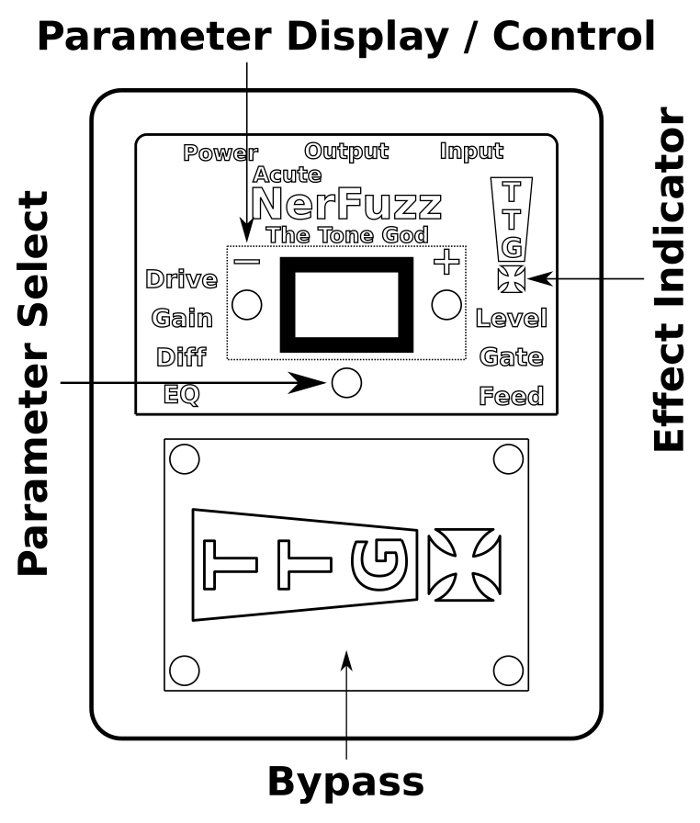
Front Panel
Bypass: The control plate alternately switches the effect between engage and bypass.
Effect Indicator: This light will illuminate when the effect is engaged.
Parameter Select: Use the touch points located to the left and right of the parameter names to cycle until the parameter to be adjusted is selected. The parameters available are Drive, Gain, Diff (Differential), EQ, Feed (Feedback), Gate, and Level.
Parameter Display: The numerical display will show the value of the currently selected parameter.
Parameter Control: Adjusts the currently selected parameter’s value.
Back Panel
Power: Power supply input. The power supply must be at least 9V. The maximum is 24V. The power can be AC or DC. The polarity of the DC plug can be either center positive or enter negative. The supply must be rated for 80mA or more.
Input: Input signal jack. The input is high impedance.
Output: Output signal jack. The output is low impedance.
Touch Interface
The NerFuzz is controlled using a touch interface system made up of a series of touch points that response only to skin contact. These points act similar to push buttons.
Note: If the touch points are not responding to touch make skin contact with either the Bypass or Memory Select (A/B) control plate while using the touch point(s).
Parameters
Drive
The Drive parameter adjusts the level of the signal going into the distortion stage. By increasing the signal level the distortion section will be driven harder creating stronger distortion. At higher settings the drive stage will start to distorted itself which can add even more distortion to the final sound similar to cascading distortion.
At lower settings the signal will be attenuated below the input’s original signal level. This can be used to adjust for higher input levels like that from high gain pickups or other effects.
Note: At high settings the noise level will increase.
Gain
The Gain parameter adjusts the amount of distortion that will be created but the distortion stage. Higher settings will create compression. Lower settings will generate little or no distortion.
Note: At high settings the noise level will increase.
Diff
The Diff parameter when positive enables the differential mode. By adjusting the Diff parameter a wide range of sounds can be created such as crossover, octave, or tripling distortion. “Metallic”, “fizzy”, “splatter”, or “thin” tones can be generated that interact with your playing. Holding notes on some settings will cause a swell effect as the note decays. Higher settings will bring on a smoother type of distortion.
Note: Adjusting the Drive and Gain parameters will affect the behavior of the Diff control.
EQ
The single band active EQ tone control will either cut or boost the low-mid frequency band. Low settings will cut the low-mids making a bright sounding fuzz. High settings will boost the low-mid band to create a thick fuzz.
Feed
The NerFuzz has an internal positive feedback loop adjusted by the Feed parameter. At lower settings the feedback will boost the distortion generated or cause filtering effects as the signal is fed back into the signal chain. If enough feedback is added the NerFuzz will start to oscillate on its own. The other parameters will affect the characteristics of the feedback. The input signal will also affect the feedback characteristics. For example adjusting the volume control on the guitar will change the pitch of the oscillation.
Note: Using buffered devices before the NerFuzz may cause problems in controlling the feedback using guitar controls.
Gate
The Gate parameter when positive engages the gate function. This will set a level at which the distortion stage will be heard. This can be used to block noise from higher Drive and Gain settings, excessive feedback from the Feed parameter, or noise in the environment like hum through pickups. The Gate can also be used to create squelched style fuzz tones like those found in vintage fuzz effects.
Level
Final output level of the effect. At higher settings the output level is boosted from the input level.
Adjusting a Parameter
Use the Parameter Select controls to scroll to the parameter to be adjusted. The parameter’s name will be lit when selected. The current value of the parameter will be displayed in the Parameter Display.
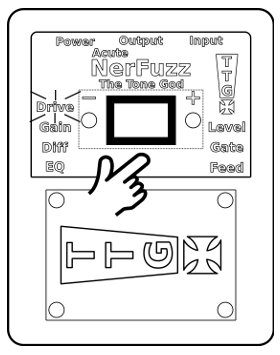
The parameter value is increased using the “+” touch point or decreased using the “–” touch point. Short taps will adjust the parameter slowly for making small adjustments. If the touch point is held for a few moments the parameter will be adjusted at a faster rate making setting a large difference value simpler. The sound output is updated as the parameter is adjusted so one can hear the sounding changing. This allows for easy dialing in of particular sound. The value range for each parameter is 00 to 99.
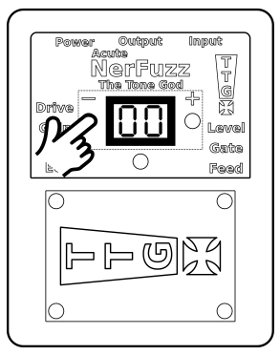
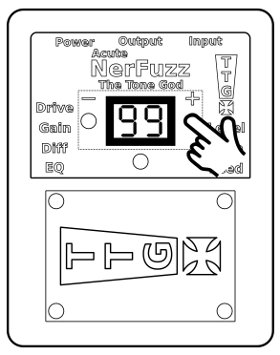
Factory Reset
To perform a factory reset hold the Parameter “–” and “+” touch points while powering the effect on. After a few moments the Effect Indicator will blink rapidly. You can now cycle the power to the effect and it will start normally. The Acute Nerfuzz will be programmed with a simple default distortion setting.
Note: There is no way to recovery the previous settings after a facotry reset is performed. It is suggested that you keep records of your favorite settings for back up purposes.
